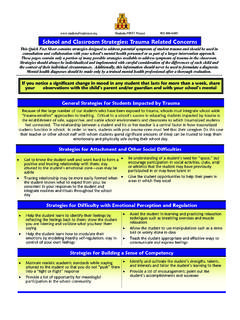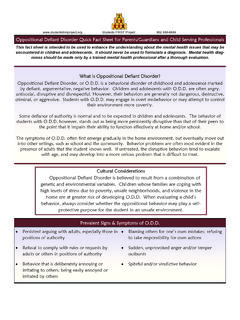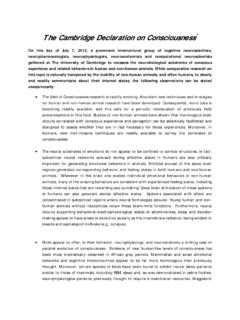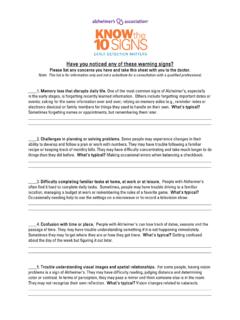Transcription of Disrupted Attachment - Students FIRST Project
1 Phone: 802 488-6689 Fax: 802 488-6666 E-mail: Students FIRST Project Students FIRST Project Quick Facts: Disrupted Attachment An Information Booklet For Parents/Guardians and Child Serving Professionals in Chittenden County, Vermont This fact booklet is intended to enhance understanding about mental health issues that may be encountered in children and adolescents. The information included is not exhaustive and should never be used to formulate a diagnosis. Mental health diagnoses should be made only by a trained mental health professional after a thorough evaluation. Students FIRST Project What is Disrupted Attachment ?
2 Healthy Attachment is a reciprocal, enduring emotional connection between a child and his/her primary care-giver(s) that begins when the child is in utero. Resulting from care-giving that is attuned and responsive to the child s physical and emotional needs, secure Attachment is an essential building block of cognitive, social, emotional, and physical development. Characteristics such as empathy, capacity to love, and inhibition of aggression are all related to a child s sense of secure Attachment in the world. For some children, this Attachment is Disrupted through a variety of circumstances such as the abrupt loss of or extended separation from a parent, child abuse or neglect, invasive and/or painful medical procedures, prenatal exposure to toxins and/or neurological problems.
3 A child is at highest risk of Attachment related problems if these disruptions occur during the FIRST two years of their life. Problems of Attachment fall along a spectrum ranging from children at the mild end who can be described as having Attachment related issues (they can attach, but may have difficulty maintaining the Attachment over time) to the wholly unattached child at the severe end of the continuum. When the symptoms of a poorly attached child lead to profoundly disturbed and developmentally inappropriate social relatedness, the child may be given the diagnosis of Reactive Attachment Disorder (RAD).
4 The subtypes of RAD are: Inhibited subtype: These children persistently fail to respond to or initiate social interactions in a developmentally appropriate way. Disinhibited subtype: These children are indiscriminate in their choice of Attachment figures. In other words, they may seek love and/or attention from anyone. Many children experience Attachment disruptions and related problems. RAD, however, is a serious diagnosis that is rarely given. Reactive Attachment Disorder Getting Linked Visit to locate mental health providers who address Attachment related problems in children and adolescents in your community.
5 Dial 2-1-1 to reach Vermont 2-1-1, a statewide health and human services information and referral program where you can get person to person assistance to find Attachment related resources in your community. Students FIRST Project Child Trauma Academy Daniel Hughes Vermont Adoption Consortium School Psychiatry Program Massachusetts General Hospital American Academy of Child and Adolescent Psychiatry Nat l. Alliance on Mental Illness VT Family Network Association for Treatment and Training in the Attachment of Children Students FIRST Project FIRST Call for Children and Families (child and family crisis services in Chittenden County) (802) 488-7777 Additional Resources Students FIRST Project Cross-cultural studies have shown that the instinct for parent-child Attachment is universal, regardless of ethnic or cultural differences.
6 However, there are children who are at greater risk for the development of Attachment related problems. These include children in families with other high risk factors such as families with a history of child abuse and neglect, domestic violence, substance abuse, and parental mental illness. Children who have experienced early harmful care, especially those involved in the foster care system who have received inconsistent care from multiple caregivers, are more likely to be diagnosed with an Attachment disorder, as are children who have been adopted following institutional deprivation, as sometimes happens with children in international orphanages.
7 Cultural Considerations Students FIRST Project Prevalent Signs & Symptoms of Disrupted Attachment Interpersonal Relationships - may include lack of trust in caregivers or adults in positions of authority; resistance to nurturance or guidance; difficulty giving and receiving genuine affection or love; superficial charm and lack of authenticity in interpersonal responses; inability to interpret facial expressions and body cues necessary for appropriate interpersonal interactions; poor social skills Emotional Functioning - may include limited capacity for emotional self-reflection; minimal ability to recognize the emotions of others; poor emotional regulation (moodiness, extreme fluctuations in emotions, falling apart when faced with stress); low self-esteem Behavior - may include demanding, clingy, and/or overt or covert over-controlling behavior; incessant chatter; temper tantrums; minimal self control; regressed behavior; chronic lying; stealing; property destruction; acting out in order to provoke anger in others; aggression; abnormal speech and eating patterns; impulsivity Cognitive/Moral Development - may include lack of understanding of cause and effect.
8 Decreased capacity for self-reflection and abstract thinking; limited compassion, empathy, and remorse; uneven learning profile (learns well sometimes but not others); difficulty concentrating and attending to school related tasks Students FIRST Project Developmental Variations Though most of the symptoms below can occur across a child s development, some may be more prominent or FIRST emerge at different developmental stages: Early Childhood Delayed development of motor skills Severe colic and/or feeding difficulties; failure to thrive Resistance to being held, touched, cuddled, or comforted Lack of response to smiles or other attempts to interact Lack of comfort seeking when scared, hurt, or sick Excessive independence.
9 Failure to re-establish connection after separation School-age Children Frequent complaints about aches and pains Age inappropriate demands for attention Disinvestment in school and/or homework Inability to reflect on feelings or motives regarding behaviors Inability to understand the impact of behavior on others, lack of response to consequences Inability to concentrate or sit still Difficulty with reciprocity (give and take) in relationships May appear amoral (lacking moral development) Lying and stealing Adolescence Aggressive, anti-social, impulsive, risk-taking, or delinquent behavior Substance abuse Higher levels of disengagement Related depression and/or anxiety Students FIRST Project Children with Disrupted Attachment often lack investment in achieving academic success as their energy is focused on self-protection from what they perceive to be an unpredictable and unsafe environment.
10 Often this focus on control and protection results in disruptive or maladaptive behavior and a difficulty displaying focused attention or concentration on school related tasks. The limited ability for self reflection and understanding of cause and effect that may be experienced by children with Disrupted Attachment can affect their follow through on common school tasks such as homework and can impact their cooperation with peers. These Students often lack responsiveness to the types of intrinsic motivation and reward that underlie many school activities, such as academic achievement or the drive to please school related adults.









